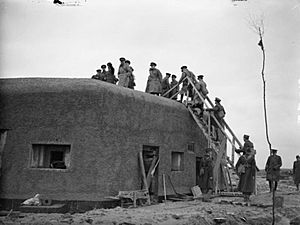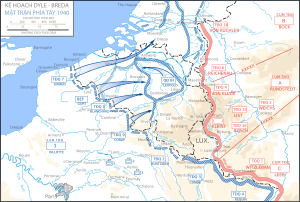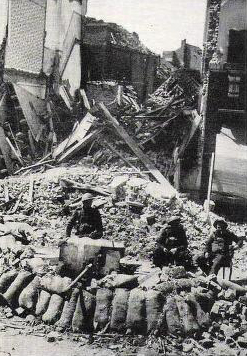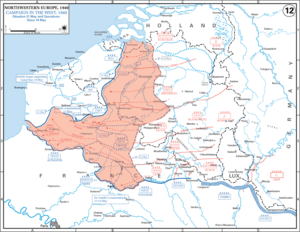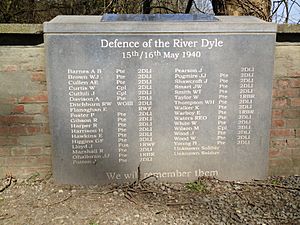Operation David facts for kids
Quick facts for kids Operation David (1940) |
|||||||
|---|---|---|---|---|---|---|---|
| Part of Battle of Belgium | |||||||
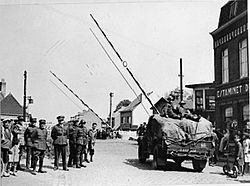 British troops of the BEF cross the border into Belgium, 10 May 1940. |
|||||||
|
|||||||
| Belligerents | |||||||
| Commanders and leaders | |||||||
Operation David was the secret name for a plan by the British Army at the start of World War II. It was part of the Battle of Belgium in May 1940. The plan involved the British Expeditionary Force (BEF) moving quickly into Belgium. This happened on May 10, 1940, the same day Nazi Germany invaded neutral Belgium.
The BEF left their strong defences near the French-Belgian border. They moved deep into Belgium to set up a new defensive line. This was part of a bigger plan by the French military leaders. The British, French, and Belgian armies formed a long defensive line. They managed to stop attacks from German infantry (foot soldiers).
However, the Allies didn't know this was a trick. The main German attack, using fast armoured divisions (tanks), was happening further south. To avoid being completely surrounded, the BEF and their allies had to retreat. They fought their way back to their starting positions by May 24. But the German tanks had already reached the coast behind them. This cut off the BEF's supplies. This led to the famous Dunkirk evacuation in the days that followed.
Contents
Planning for Defence
In the years between World War I and World War II, French military leaders wanted to make France's borders very strong. They started building the Maginot Line in 1930. This was a line of forts and bunkers. In 1932, they decided not to build forts on France's northeastern border. This area was low and wet, making building difficult. Also, France had a military agreement with Belgium since 1920.
So, France decided the best way to protect itself from Germany in that area was to defend Belgium. This meant any fighting would happen in Belgium, not in France. This would protect important French industrial towns. But this plan changed in 1936. Belgium decided to be a neutral nation and ended its military agreement with France. This meant the two armies could not plan their defence together if Germany invaded.
French planners looked at three possible defence lines inside Belgium.
- The first was along the Albert Canal. This canal was close to the Belgian border with Germany. But if Germany invaded, French forces might not have enough time to get there before the Germans crossed it.
- The second was the Scheldt River (called Escaut in French). This river ran through Ghent to Antwerp. It was a strong natural barrier. But defending the Escaut Line (Plan E) meant giving up a lot of Belgian land, including Brussels.
- The third idea was to form a line along the River Dyle (Plan D). This line would protect more Belgian cities and was shorter than the Escaut Line. However, the Dyle River was quite small in places. Also, the Dyle River didn't reach the River Meuse. This left a gap of about 40 kilometers (25 miles) without natural barriers. This open area near Wavre was called the "Gembloux Gap."
In September 1939, the BEF arrived in France. General Lord Gort commanded them. They became part of the French 1st Army Group. This group was in charge of defending France's border with Belgium and Luxembourg. The BEF's part of the border was near Armentières and Lille. The British started building trenches, weapon pits, and small concrete forts called pillboxes. This became known as the Gort Line.
At first, Maurice Gamelin, the French Commander-in-Chief, liked Plan E (the Escaut Line). But then the Belgians started building some defences along the Dyle Line (which they called the K-W Line). This made Gamelin change his mind. On November 9, Allied commanders agreed to use Plan D, the Dyle Line. The British were not sure about moving into Belgium. But the BEF was much smaller than the French armies, so Lord Gort felt he had to agree.
In January 1940, a German plane crashed in Belgium. It was carrying secret invasion plans. These plans showed that Germany would attack through Belgium, just like in 1914. They also showed Germany planned to invade part of the neutral Netherlands. Because of this, Gamelin changed Plan D in March. This new plan was called the "Breda Variant." The French Seventh Army would move to the border. If Germany invaded, they would race north to Breda in the Netherlands. Their job was to protect Antwerp.
In the final plan, the Belgians were supposed to slow down the German advance. Then they would retreat from the Albert Canal to the Dyle River. The BEF would defend about 35 kilometers (22 miles) of the Dyle River. This was from Louvain to Wavre. The French First Army would defend the area south of the BEF. This included the Gembloux Gap.
By March 1940, the BEF had grown to nearly 400,000 men. By May 1940, the BEF had 10 infantry divisions. They also had air support from the Royal Air Force (RAF). Lord Gort's headquarters had reserve troops, tanks, and other support units.
Moving into Position

At 1:00 a.m. on May 10, 1940, the French headquarters received news that the German invasion was about to begin. At 4:35 a.m., Germany invaded France and the Low Countries (Belgium, Netherlands, Luxembourg). Gamelin ordered the Dyle Plan to start. The secret word "Operation David" began the British part of the plan.
The first British troops, led by armoured cars of the 12th Royal Lancers, crossed the border at 1 p.m. on May 10. Belgian civilians cheered them on. The BEF's section of the Dyle River was about 35 kilometers (22 miles) long. Lord Gort decided to put only three divisions on the front line. This meant each division had to defend a longer area than usual. The BEF had enough trucks to move these three divisions. This move was planned to take almost four days. Other BEF divisions had to march towards their positions.
When the 3rd Division arrived at the Dyle River near Louvain, they found Belgian troops already there. The Belgians refused to move. Lord Gort had to ask the King of the Belgians for help. Finally, the Belgians were ordered to move. British infantry battalions started arriving on May 11. They began digging trenches. The Belgian defences already there were only a few scattered pillboxes and some barbed wire. British light tanks and Bren carriers protected these preparations. They kept German scout patrols away. These light tanks were pulled back on May 14. Then, the bridges over the Dyle were blown up to stop the Germans.
Defending the Dyle River
The first German soldiers appeared on the BEF's front on the afternoon of May 14. They were scout troops in cars or on motorcycles. They seemed unaware of the British positions. In some places, they approached the Dyle River without cover. This made them easy targets for British guns. Later that evening, German field guns fired on parts of the line. This was the first time many British troops experienced enemy fire.
Organized German attacks began on May 15. The German 19th Infantry Division attacked Louvain. The British 3rd Division, led by Major General Bernard Montgomery, pushed them back. On the left side of the line, the 1st Grenadier Guards had to give up their forward positions. They pulled back behind the Dyle Canal. But the line held there.
The next morning, after a two-hour artillery attack, the Germans made a strong push. They attacked Louvain railway station and the nearby goods yard. After a long fight, the British pushed them back. This was done by the 1st Royal Ulster Rifles and the 1st King's Own Scottish Borderers.
Further south, the Dyle River was only about 4.5 meters (15 feet) wide. It stopped tanks but was less of a barrier for determined infantry attacks. During one attack near Wavre, 2nd Lieutenant Richard Annand of the 2nd Durham Light Infantry showed great bravery. He stopped German troops from crossing a destroyed bridge. He repeatedly threw grenades at them. When he was finally ordered to retreat, he tried to rescue a wounded soldier. He earned a Victoria Cross for his actions.
All German attempts to cross the Dyle were either stopped or contained by British counter-attacks. But by the morning of May 16, things had changed far to the south. Lord Gort was ordered to pull the BEF back to the Escaut River.
What Was Happening Elsewhere
The French Seventh Army pushed forward on the northern side. Their leading units reached Breda on May 11. But they found that German paratroopers had captured the Moerdijk bridges. This cut off the link between southern and northern Holland. The Dutch Army had to retreat north. The French tanks then met the German 9th Panzer Division. The French advance was stopped by German infantry, tanks, and Ju 87 (Stuka) dive-bombers.
The Breda plan failed in less than two days. On May 12, Gamelin ordered the Seventh Army to stop the plan and cover Antwerp. On May 14, the Dutch surrendered.
In Belgium, the Albert Canal defence line relied on the strong fort of Eben-Emael. German glider troops landed on its roof and captured it by noon on May 11. Two bridges over the Maas (Meuse) River were also captured. This disaster forced the Belgian Army to retreat towards the line from Antwerp to Louvain on May 12. This was too soon for the French First Army to arrive and dig in.
The French cavalry reached the Gembloux Gap on May 11. Officers reported that the Belgians had fortified the area much less than expected. There were no anti-tank defences, trenches, or concrete forts. There were some steel barriers, but they were not protected by anti-tank mines. Some barriers were so badly placed that a French officer wondered if the Germans had been asked where to put them.
On May 15, the Germans attacked the French First Army along the Dyle Line. This led to a direct fight that Gamelin had tried to avoid. The First Army pushed back the German XVI Panzer Corps during the Battle of Gembloux. But the French headquarters realized too late that this attack was a trick. The main German attack had come further south. There, a large German army group had broken through the lightly defended Ardennes forest.
Retreat to the Escaut River
On May 16, the 1st Army Group was ordered to retreat from the Dyle Line. This was to avoid being trapped by the German breakthrough against the French Second and Ninth armies. By May 20, the Germans reached Abbeville on the English Channel coast. This cut off the northern Allied armies.
The BEF's retreat plan was to pull back at night. Units would quietly leave their positions in stages. The first goal for the night of May 16/17 was the Charleroi to Willebroek Canal. The next night, they would move to the River Dendre. Finally, on May 18/19, they would reach the Escaut River.
The order to retreat surprised and frustrated the British troops. They felt they had held their ground well. But they didn't know how bad the situation was elsewhere. Luckily, the BEF had practiced retreating while still fighting the enemy. This is a very difficult military move. The retreat started at 9 p.m. under heavy British artillery fire. The artillery used up all its stored ammunition. The withdrawal mostly went as planned.
On the far left of the British line, the situation became tricky. The Belgian troops next to them pulled back early. This allowed the Germans to go around the British 1st Coldstream Guards. The Germans occupied the town of Herent, which was on the British retreat route. Hard fighting, including a bayonet charge, was needed to clear the road. This cost the Guards 120 casualties. The last units to leave the line were the cavalry regiments in their light tanks. A later communication problem caused a complete loss of contact with the Belgian Army. A dangerous gap opened up between the two forces. Luckily, British light armoured vehicles covered it before the Germans could find and use it.
Defending the Escaut River
On the British part of the Escaut River, seven BEF divisions were on the front line. They faced nine German infantry divisions. The Germans began their attack on the morning of May 21 with a huge artillery bombardment. Soon after, infantry attacks started along the whole front. They crossed the river using inflatable boats or by climbing over the remains of destroyed bridges.
The Escaut line was broken in many places. But all German crossings were either pushed back or contained by strong British counter-attacks. These counter-attacks were costly for the British. The remaining German troops were ordered to retreat back across the river by the night of May 22. One British counter-attack near the village of Esquelmes was led by Lance Corporal Harry Nicholls. He was captured and later awarded the Victoria Cross for his bravery.
Retreat to the Gort Line
On May 22, Lord Gort met with his commanders. They agreed that the Escaut Line could not be held for long. A retreat was planned for the next night, May 23/24. Meanwhile, General Maxime Weygand had taken over from Gamelin. He met with King Leopold of Belgium and proposed a new defensive line. The Belgians would defend the River Lys. The British would retreat to their border defences, the Gort Line. This was hoped to allow the BEF to attack the German army's exposed side on May 26.
Weygand hoped the Belgians would retreat to the shorter River Yser line, as they did in 1914. However, King Leopold did not want to give up so much Belgian land. This might have shown he did not plan to fight a long war. Lord Gort knew a meeting was planned, but his headquarters had communication problems. He didn't know the time or place. Belgian officers finally found him. Weygand had left before Gort arrived. Weygand thought Gort had purposely been absent. In a final meeting, Weygand's plan was agreed upon without Gort being able to explain the difficulties. The French commander Billotte was fatally injured in a car accident on his way back. This caused more confusion.
Starting on May 17, Lord Gort began to create new groups of soldiers. He wanted to protect the BEF's exposed southern side from the German Army Group B. These forces used the canal line from Gravelines on the coast through Saint-Omer, Béthune, and La Bassée. The town of Arras was being held by a determined British group. To support them, a small force with the BEF's only heavy tanks attacked south on May 21. This attack, known as the Battle of Arras, surprised the Germans. But it didn't achieve much in the long run.
The retreat from the Escaut went smoothly on the southern end of the line. Light armoured vehicles again provided good protection for the retreating troops. However, in the far north, the 44th Division had trouble contacting all its units. There were no radios below battalion level. Field telephone lines had been cut by heavy shelling and bombing. Messages had to be sent by runners or in vehicles. Many of these fell victim to enemy fire. For the first time in the campaign, the Germans kept pushing forward at night. The 44th and nearby 4th Divisions had to fight their way out.
What Happened Next
By May 24, the BEF was back where it had started. But now the enemy was behind them as well as in front. They were cut off from their supplies. Troops had been put on half-rations the day before. Also, almost all of the RAF Air Component had gone back to England. This made air support very difficult. Much of the air effort had been sent to help fighting at Boulogne and Calais.
The shorter front line and better defences at the border allowed Lord Gort to move the 2nd and 48th Divisions towards Lille. This was to strengthen the defence of the Canal Line. On May 25, it became clear that an evacuation was needed. Brooke's II Corps was ordered to form a defensive line on the Ypres-Comines Canal. This was to create a safe path for the main BEF forces to retreat towards the coast. This was the start of the Battle of Dunkirk.
The special honours given to British regiments for fighting in Operation David include: "Northwest Europe 1940," "Dyle," "Withdrawal to the Escaut," and "Defence of Escaut."


